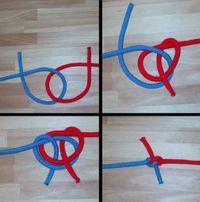(corrected jamming property description) |
|||
| Line 1: | Line 1: | ||
[[Image:Hunters Bend HowTo.jpg|right|thumb|200px|hunter's bend step by step]] | [[Image:Hunters Bend HowTo.jpg|right|thumb|200px|hunter's bend step by step]] | ||
| − | '''Hunter's bend''', also known as '''rigger's [[Bend knot|bend]]''', is a knot used to secure two lines. It consists of 2 interlocking [[overhand knot]]s. The [[knot]] can jam under even moderate strain. | + | '''Hunter's bend''', also known as '''rigger's [[Bend knot|bend]]''', is a knot used to secure two lines. It consists of 2 interlocking [[overhand knot]]s. The [[knot]] can jam under even moderate strain. Its usefulness lies in its permanant 'open-ness', ie. it does not tighten up on itself under load so can still be immediately and easily undone. |
Hunter's bend is one of the most recent knots to be discovered. Named after Mr. Hunter, a British man who used it for years to tie broken shoelaces before discovering its originality through a friend in the 1970s, when it made national TV news. | Hunter's bend is one of the most recent knots to be discovered. Named after Mr. Hunter, a British man who used it for years to tie broken shoelaces before discovering its originality through a friend in the 1970s, when it made national TV news. | ||
Revision as of 13:23, 18 May 2006
Hunter's bend, also known as rigger's bend, is a knot used to secure two lines. It consists of 2 interlocking overhand knots. The knot can jam under even moderate strain. Its usefulness lies in its permanant 'open-ness', ie. it does not tighten up on itself under load so can still be immediately and easily undone.
Hunter's bend is one of the most recent knots to be discovered. Named after Mr. Hunter, a British man who used it for years to tie broken shoelaces before discovering its originality through a friend in the 1970s, when it made national TV news.

